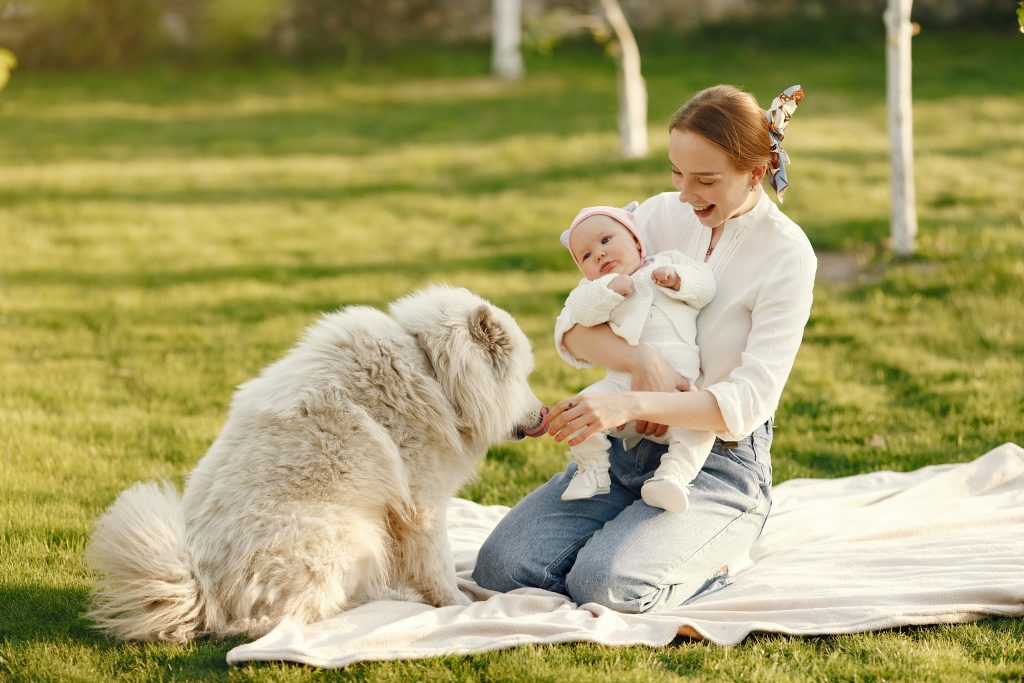Preparing your pet for the arrival of your baby
By Dorothée Pâris Pasturel • 10 December 2024
Welcoming a new baby into the family is a magical time, but it can also be a big adjustment for your furry friend. As parents-to-be, it’s essential to prepare your pet for baby’s arrival to ensure a smooth transition for everyone involved.
Start early
Prepare your pet for the baby’s arrival as soon as possible. This gives you plenty of time to address any behavioral issues and gradually introduce changes to their routine.
Start a new routine
Your daily life and schedule will definitely change when your baby arrives. It is therefore advisable to prepare your pet for this change gradually. For example, start walking him at lunchtime and also give him his food a little later in the morning.
Introduce new sounds and smells
To help your pet acclimate to baby sounds and smells, gradually introduce them to these stimuli before the baby arrives. Use baby products such as lotions and allow your pet to explore baby furniture and accessories. Play recordings of your baby crying and then give your dog a Kong filled with food while he plays.
Setting limits
Setting boundaries early on is essential for the safety of both your pet and the baby. If there are any, decide which areas of the house will be off-limits to your pet once the baby arrives. Use gates to restrict access to these areas and provide your pet with his own safe space, such as a crate , where he can retreat when needed. Don’t be afraid to give him interactive toys or chew bones when he’s behind a gate to create a positive association.
Reinforce positive behavior
Whenever your pet demonstrates calm, appropriate behavior around baby-related objects or situations, be sure to praise and reward him. This will help reinforce positive associations and encourage desirable behavior around the baby.
Here is a video explaining how to teach your dog to “Down and Mat”: https://www.youtube.com/watch?v=k2eduDeNLXY
Progressive exposure
Once the baby arrives, introduce him to your pet gradually and in a controlled manner. Do not introduce his face, but rather his feet. Let your pet sniff the baby while closely monitoring his interactions. Reward calm and gentle behaviors and remove your pet to a quiet area if he shows signs of stress or agitation.
If your dog growls in the presence of the baby, move them away from each other, without scolding your dog, and try to understand the reason for the growling (see the Humanimo.org website).

Satisfying your pet’s needs
With a new baby in the house, it’s easy to neglect our pet. Make the effort to spend quality time with him every day, even if it’s just a few minutes. His physical activities will necessarily be temporarily reduced, so think about offering him more mental activities through interactive games and bowls and objects to chew (bones or toys).
Read our article on the subject.
Monitor interactions
Always supervise the interactions between your pet and the baby. Even the most well-behaved pet can become unpredictable in certain situations. It is therefore crucial to remain vigilant and intervene if necessary. Never leave your pet alone with the baby and teach your child to respect the animal’s space and boundaries.
It may be that, despite all your efforts, your dog is definitely not comfortable with your child. This happens, especially for dogs whose past is unknown or who have already experienced a stressful situation with a child. Do not hesitate to talk about it with a dog trainer (website: rqiec.com ) who will be able to give you solutions or recommendations.





Leave a Reply